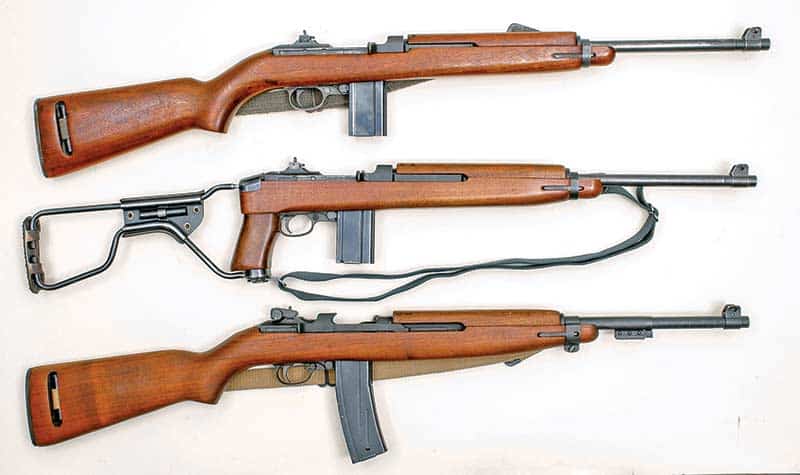The carbine as we know it today has its roots in 16th-century Europe. Early carbines were essentially cut-down versions of full-length muskets, with barrels shortened to around 20 inches to reduce weight and make the firearms more maneuverable on horseback. These primitive muzzleloading carbines sacrificed range, accuracy, and power for portability.
The First Carbines
The first true carbines designed specifically for cavalry use emerged in the early 1600s. The French introduced the short “dragoon” carbine, while the Germans developed the Karabiner, from which we get the English word “carbine.”

These early carbines fired a relatively small pistol-sized bullet from barrels of just 24-36 inches. They were built for mounted troops who rode alongside the heavily armored cuirassiers. As such, maneuverability and rapid fire from horseback were prized over firepower and long-range accuracy.
Through the 17th and 18th centuries, carbines continued to use matchlock, wheellock, or flintlock ignition systems. They were single-shot black powder arms loaded with paper cartridges. Flintlock systems enabled lighter, shorter lock mechanisms that further reduced carbine size. Historical military carbines of this period include the British 1796 Light Cavalry Carbine, Austrian Model 1717, and French 1777 Charleville carbine.

Technology and the 19th Century
The 19th Century brought many revolutionary changes in firearms technology — most importantly, the advent of rifling, which dramatically improved accuracy and effective range. Rifling marked a major turning point in the evolution of both muskets and carbines.
Single-shot black powder rifles like the Kentucky Rifle and the early breech-loading Sharps Rifle were soon made in carbine versions. These rifled carbines retained the compact size and fast handling qualities necessary for cavalry use while providing superior accuracy at extended ranges compared to smoothbore arms. Examples include the Hall carbine and the Spencer carbine firing rimfire metallic cartridges.
During the American Civil War, cavalry forces on both sides made extensive use of single-shot breech-loading carbines. Union troops used the Sharps, Spencer, and Burnside carbines, while Confederate troops often relied on imported British-made Kerr and Enfield carbines. These .52 to .56 caliber carbines had effective ranges of 200 yards or more – a major tactical improvement over smoothbore arms.
The development of repeating rifles also impacted carbine evolution. Lever-action carbines like the Model 1866 Winchester “Yellow Boy” provided Cowboys, frontiersmen, and cavalry with a compact, fast-firing arm. The Winchester Model 1873 and Model 1892 lever actions in pistol calibers further refined the concept. Other common lever-action carbines of the late 1800s included the Spencer, Ballard, and Marlin.

Around this time, the U.S. Cavalry began adopting modern European breech-loading carbines with bolt or rotating block actions. The Springfield Model 1865 “Trapdoor” carbine marked the beginning of the transition, along with the Model 1871 Remington rolling block carbine. These single-shot arms paved the way for domestic and foreign bolt-action carbine designs issued through World War I.
20th Century Carbines
The early 20th Century saw carbines become truly modern firearms. The introduction of the .30-06 cartridge spurred the development of the famous 1903 Springfield rifle and carbine based on the Mauser 98 bolt action. Other militaries soon followed suit, developing carbine versions of standard infantry rifles like the British SMLE and German Karabiner 98k. These magazine-fed bolt actions provided a good balance of power, accuracy, and a compact, fast-handling package.
The origins of the famed M1 carbine can be traced back to the late 1930s when the U.S. Army recognized the need for a lightweight and compact “light rifle” that could equip soldiers whose roles did not require full-size service rifles. Infantry, artillery, tank crews, signal corps, and other support troops needed a highly portable weapon with more accuracy and power than pistols or submachine guns. This need was further amplified by Germany’s use of paratroopers and glider troops, which highlighted the requirement for maneuverable firearms that allowed rapid reaction.

In 1938, the Army Chief of Infantry requested the development of a carbine meeting these capabilities. By 1941, major firearms manufacturers, including Winchester, had submitted prototypes firing an innovative intermediate .30 caliber cartridge. The design by David Marshall “Carbine” Williams, with its short-stroke piston, was ultimately selected. This became the famous semi-automatic M1 carbine, formally adopted in 1941. Weighing only 5 pounds with an 18-inch barrel, the M1 carbine provided crucial portable firepower out to 300 yards for support troops and vehicle crews.
The M1 carbine saw its combat debut in 1942, proving effective in the hands of airborne troops during the invasion of Sicily. Its lightweight design allowed it to be readily air-dropped in a special padded container. The carbine’s short length was also advantageous in the close-quarters fighting of the Italian campaign.
In the Pacific theater, Marine units found the M1 carbine met their requirements for a weapon smaller than the standard M1 rifle in the dense jungle terrain. The carbine offered more sustained firepower than pistols or submachine guns when short distances and sudden close engagements were common.
During the Battle of the Bulge in 1944, many support troops, including cooks and clerks, found themselves suddenly on the front lines, relying on their issued M1 carbines to hold back German attacks. The semi-auto fire, low recoil, and 10-round magazine capacity enabled rapid volleys, while the carbine’s small size could be maneuvered and fired from improvised field fortifications.
Selective-fire models emerged from the request of Lieutenant Colonel Rene Studler, who recognized the need for both semi-auto and full-auto modes of fire. The M2 carbine with these dual capabilities was issued in late 1944, followed by the improved M3 in 1945. They remained in service during the Korean War, where their high rate of fire was valued.
Post WWII
After WWII, European advances like the German StG44 drove experimentation with intermediate rounds like .30 Carbine. This led to scaled-down M1 carbine derivatives firing 5.56x45mm like the CAR-15 in Vietnam. The short-stroke gas piston system pioneered in the M1 carbine strongly influenced Eugene Stoner’s design for the M16 rifle.
As U.S. involvement in Vietnam escalated in the 1960s, American troops often obtained the classic carbines on the thriving local arms black market or via deals with allied units. They recognized the M1’s balanced attributes that made it effective a generation earlier.
Another influential design was the Colt Commando, introduced in the late 1960s with an even shorter 11.5-inch barrel and collapsible buttstock for maximum portability and handling in dense terrain or urban environments. Meanwhile, Israel’s Galil ARM spawned the Galil Sniper carbine in the 1970s, equipped with an 18-inch barrel and bipod to optimize its accuracy in a military sharpshooting role.
The 1970s and 1980s marked an important transition period for the carbine concept, as it evolved from earlier submachine gun designs into specially tailored, shortened variants of standard combat rifles. No longer an entirely separate weapon system, the modern carbine became a compact yet sufficiently powerful version of a full-length rifle platform. This provided pivotal firepower in close quarters for special operations troops and support units alike.

By the mid-1970s, shortened carbine models of the M16 rifle began emerging, including early versions of what would become the ubiquitous M4 carbine. The modern evolution of the carbine continued with the introduction of the 5.56mm caliber M16 and its compact M4 variant which incorporated hard lessons from jungle combat. With its minimal recoil and use of lightweight synthetics, the M16/M4 platform extended the carbine’s proven template into a versatile modern weapon system.
Though firing a pistol caliber, Heckler & Koch’s MP5 submachine gun and its shortened MP5K variant introduced in 1976 also provided conceptual overlap with compact carbines in close-quarters use. Integrated optic sights introduced in the late 1980s modernized aiming, a technology that migrated to the new M4 carbine. By balancing rifle power in smaller packages, the modern carbine evolved to meet the needs of late 20th-century warfare.
The initial CAR-15 carbines designed by Colt used a shortened 14.5-inch barrel on the existing M16A1 platform, creating a much more maneuverable weapon suited to tight spaces without sacrificing the 5.56mm rifle cartridge. As the redesigned M16A2 rifle entered service in 1984, special forces and special ops units continued using the carbine variants based on the M16A1. By the 1990s, the M4 carbine would officially replace the CAR-15 models and similar precursors.
The M4 carbine entered service in the 1990s as a compact variant of the standard M16A2 assault rifle. It featured a 14.5-inch barrel and collapsible stock, reducing weight and improving mobility in close-quarters combat compared to a full-length M16. The modular design allowed easy customization with optics, lasers, grips, and lights to meet evolving combat needs.

In the post-9/11 era, the M4 soon eclipsed the longer M16 as the primary infantry weapon for U.S. troops deployed to Iraq and Afghanistan. Its smaller size was valued in urban warfare and clearing buildings. Vehicle crews, special forces units, and support personnel also relied heavily on the M4 for its handiness and firepower. By the 2010s, over 500,000 M4 carbines were in service across all branches of the U.S. military.
However, the M4 suffered from reliability issues in the gritty combat environments of Iraq and Afghanistan. Exposure to sand, dust, and wear degraded performance compared to the Kalashnikov rifles widely used by insurgents. In 2007, a comprehensive reliability study found the M4 malfunctioned over twice as often as the Cold War-era M16A4.
This led to major upgrades to the M4 that improved durability and part interchangeability between carbine variants. The adoption of heavier barrels, revised gas systems, and ambidextrous controls also enhanced the M4’s capabilities. Special Operations Forces (SOF) made extensive modifications for suppressed use, long-range accuracy, and other specialized needs.
The wars accelerated the development of competing carbine platforms such as the FN SCAR, HK416, and SIG Sauer MCX seeking to replace the M4. But cost and familiarity kept the M4 as the predominant carbine even 15 years into constant combat deployments. Its customized variants continued serving on the frontlines through the withdrawal of U.S. forces in the late 2010s.
The M4’s longevity in Iraq and Afghanistan reaffirmed the carbine’s vital place in modern warfare. While technical shortcomings were exposed, upgrades restored confidence in the platform. The M4 provided a versatile balance of size, ergonomics, and firepower that could be tailored to evolving missions – cementing the carbine’s reputation as one of the most battle-proven firearms ever shoulder-fired by American troops.
Today’s Carbine
Today, both military and civilian carbines benefit from continued materials and ergonomic innovations. Elite forces utilize short-stroke gas piston AR-style carbines for reliability, often with suppressors attached. Bullpup carbines with ambidextrous controls, like the IWI Tavor and Steyr AUG, provide carbine length in even more compact packages. Civilian shooters enjoy an endless supply of carbines, including modern sporting rifles, pistol-caliber carbines, and affordable surplus arms like the SKS.
After centuries of technological evolution, today’s carbines bear little resemblance to their front-loading ancestors. But they continue to embody the key qualities that define the archetype – compact size, light weight, and rapid handling.
The modern carbine has become one of the most popular and versatile firearms, suitable for roles ranging from home defense to special operations. With ongoing innovation, the flexible carbine platform appears poised to remain a vital part of military and civilian armed defense for the foreseeable future.


